“These bicyclists are extremely rude, and they take up the road — four, five people at a time,” complained one caller to NPR member station KPCC’s show AirTalk. The caller said he lives in Mandeville Canyon, and he has had it with cyclists.
“When you pull up alongside them and ask them to stay out of your way, they yell at you,” he said. “They’re extremely provocative, they’re asking for trouble, and this is not the worst case that’s going to happen. Someone’s going to get killed, and to be frank with you, the residents aren’t going to feel too bad about it.”
from ‘Road Rage’ Case Highlights Cyclist Vs. Driver Tension, All Things Considerd, NPR

Ok, so I admit it, I’m one of those cyclists who has broken traffic laws: I have run stop signs, ridden on sidewalks, and on occasion entered a one-way street on the wrong end. That said, I pride myself for never having run a red light, not even in the middle of the night in pouring rain with no cars to be seen anywhere. I swear, it’s one of those weird irrational obsessions of mine, like refusing to see The Sound of Music or stepping into a KFC, even to use the bathroom.
Although I’m probably one of the few and distinguished folks who has ever received a moving violation ticket on a bicycle (Yup, that old stop sign was in the way), I consider myself very respectful and low on the aggro scale as far as fighting my way through the concrete jungle: I often stop for pedestrians, give bus drivers big smiles, and on occasion even signal the baffled driver of an SUV to cross the intersection ahead of me.
However, while the discussion surrounding rude cyclists may often play out in the public eye as an issue of common courtesy or the lack thereof, the underlying conflict is rooted in a much bigger question, the question of Justice.
justice [ˈdʒʌstɪs]
1. the quality or fact of being just
2. (Philosophy) Ethics
a. the principle of fairness that like cases should be treated alike
b. a particular distribution of benefits and burdens fairly in accordance with a particular conception of what are to count as like cases
The problem with the idea that cyclists should just abide by existing traffic laws is that it assumes that bicyclists and automobile drivers are “like cases.” Now, it doesn’t take an extraterrestrial to see that the traffic participants in this photo are not “like cases:”
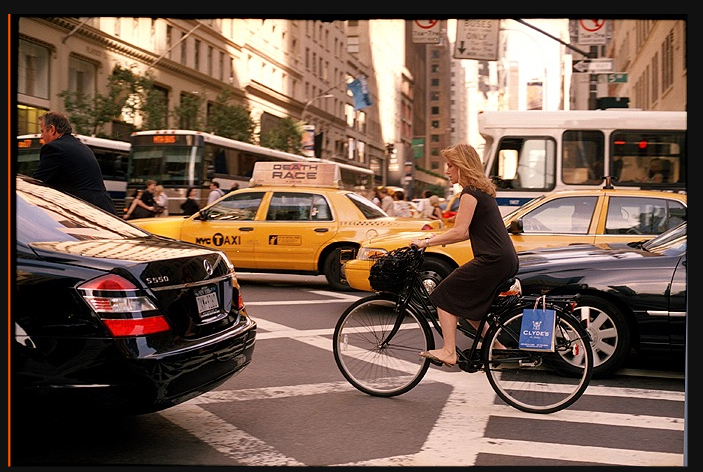
Bill Cunningham, The New York Times
One of the prerequisites of fairness or justice is a level playing field, and it’s pretty obvious that the playing fields have been altered significantly over the last 100 years in favor of the players with the 5000 pound armor around them. Consider this:
In 1990, the Federal Highway (FHWA) Administrator described bicycling and walking as “the forgotten modes” of transportation. For most of the preceding decade, these two nonmotorized transportation options had been largely overlooked by Federal, State, and local transportation agencies. An average of just $2 million of Federal transportation funds were spent each year on bicycle and pedestrian projects, and the percentage of commuting trips made by bicycling and walking fell from a combined 6.7 percent to 4.4 percent. Source: National Bicycling and Walking Study
While funding for bicycle and pedestrian infrastructure has increased since the study was conducted, most federal, state and local funding for transportation still goes toward maintaining our automobile-dominated infrastructure. One could argue that because only 0.8% percent of all trips combined are taken by bicycle, the logical conclusion would be to allot funding and support accordingly. However, even such proportional funding is considered “controversial.” As some prominent members of Congress showed in their reaction to the 2009 American Recovery and Reinvestment Act, committing $825 million, or 0.3% of the 27.5 billion dollars for highway funds and transportation enhancements to bicycle and pedestrian projects is nothing more than special-interest pork-barrel spending.
“I think there’s a place for infrastructure, but what kind of infrastructure? Infrastructure to widen highways, to ease congestion for American families? Is it to build some buildings that are necessary?” He stated. “But if we’re talking about beautification projects, or we’re talking about bike paths, Americans are not going to look very kindly on this.”
– Republican House Leader John Boehner on Bikes and Beautification
When people see bike trails and hiking trails and golf courses, they know this is not designed to stimulate the economy and create jobs. It’s just basically special-interest pork barrel spending. (qtd. by L.A.B.)
Does this look like a leisurely day on the golf course or do you see the potential for easing congestion in this photo?
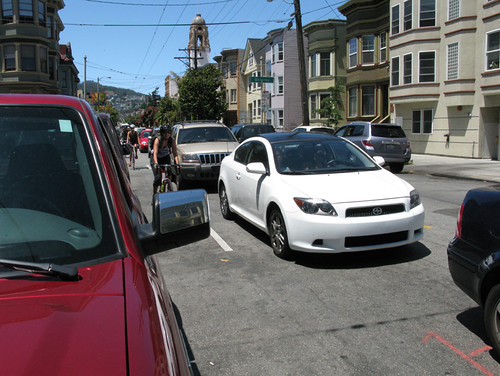
What we have here, in my humble opinion, is a classic case of discrimination. One particular group establishes itself as the dominant culture, whether through deliberate economic power plays or through a series of public works decisions and massive subsidies, causing shifts in popular perception and leading to a new majority (drivers). At some point this new majority is so big that it doesn’t even look at itself as majority anymore, just as “normal.” The only way to live a “normal” life is to be part of the dominant culture, in this case, drive a car. Just as with privileges based on race, gender, sexual orientation or economic status, most people who fall into the dominant culture don’t ever think about how much had to happen for this “normal” reality to come into existence. You may laugh at me, but whenever I hear about the straight white upper middle class male privilege, I can’t help but include “driver” on that list.
Just as most people aren’t openly racist or homophobic, most people don’t harbor any animosity against cyclists, generally speaking. It’s only when some cyclists disrupt the flow, break the rules, get uppity, that the dominator culture flexes its muscle and a ferocious backlash ensues.
Sometimes this backlash even gets poetic:
These particular arses seem to come in only two types: bony and constipated with suppressed fury at the injustice of a world that even allows automobiles onto the roads; and vast, wobbling mounds of hairy dimpled horror bursting like a badly made sausage from undersized lycra bike shorts to burn the retinas of those innocent drivers trapped in the inevitable traffic jam that forms immediately behind them.
John Birmingham, Blunt Instrument blog, Brisbane Times
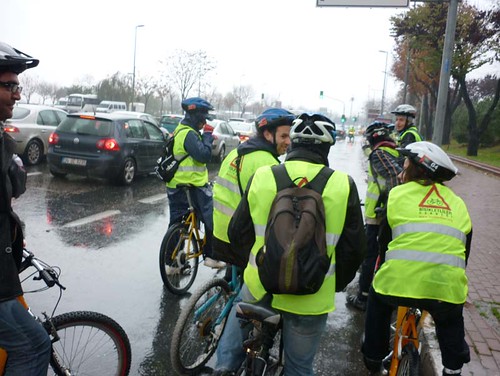 The basic chorus is that We don’t mind cyclists, as long as they play by the rules like everyone else, meaning they should behave like drivers. In fact, all 50 states have legal rights for cyclists, which in theory makes them equal to drivers. The problem with this, of course, is that as a cyclist you are still on drivers’ home turf: Try using your equal right to ride in the center of your lane and see how tolerant and accommodating the driver behind you really is. I could put together a whole list of situations in which cyclists are at a great disadvantage in “normal” traffic, as in How to Not Get Hit by Cars.
The basic chorus is that We don’t mind cyclists, as long as they play by the rules like everyone else, meaning they should behave like drivers. In fact, all 50 states have legal rights for cyclists, which in theory makes them equal to drivers. The problem with this, of course, is that as a cyclist you are still on drivers’ home turf: Try using your equal right to ride in the center of your lane and see how tolerant and accommodating the driver behind you really is. I could put together a whole list of situations in which cyclists are at a great disadvantage in “normal” traffic, as in How to Not Get Hit by Cars.
Another dilemma similar to other institutionalized injustices is that instead of banding together, minority groups often end up fighting for scraps. In this case, as cyclists are often pushed out of the streets and onto side and- crosswalks, it is pedestrians who turn most vociferously against their natural allies:
Re: “Bicyclists ignore sidewalk sign” (Chronicle Watch, Aug. 24): Scofflaw bicyclists routinely ignore traffic laws, which they are obligated to follow. The California Vehicle Code forbids riding on sidewalks unless the bicyclists are 12 or younger. Sidewalk riding is not a legal option for adult bicyclists.
California law needs to be changed to require registration/licensing of bicycles and bicyclists so the pedestrian public can be protected. Let’s start a state campaign to require bicycles and bicyclists to be tested, registered, insured and licensed and pay appropriate fees for this regulatory service.
The free ride is over.
FIONA McGREGOR
San Francisco
Clearly, we have created a culture and infrastructure that is for, by, and of the drivers. This may have been in the public interest 50 years ago, before gridlock, urban sprawl, obesity, pollution and climate change began to pose serious problems to everything from city planning and public health to environmental degradation and our very survival on planet Earth. As we are collectively becoming more aware of the true costs of driving a car, it is very much in the public interest to change the playing field to reflect these new realities.
As with any other institutionalized injustice or imbalance, it is no longer sufficient to simply preach tolerance while leaving a skewed system in place, that is to say Hey cyclists, you’re free to use my road, as long as you stay out of my way. Both cyclists and pedestrians deserve an infrastructure not only proportional to their current representation in traffic, but to an increase in numbers that would happen if there were more safe and dedicated bike lanes in urban areas.
This is not a Utopian vision, for there are specific examples of what is possible when sufficient resources are allocated toward a bicycle infrastructure: In Copenhagen, 36 percent of its commuters bike to work every morning. In Amsterdam, 60% of all trips in the city center are made by bicycle. Closer to home, Portland’s bicycle network has grown from 60 to 260 miles since the early 1990s, and in San Francisco, the SF Bicycle Coalition has now over 10,000 members and 16% of the city’s population bicycle regularly for transportation (at least once per week).
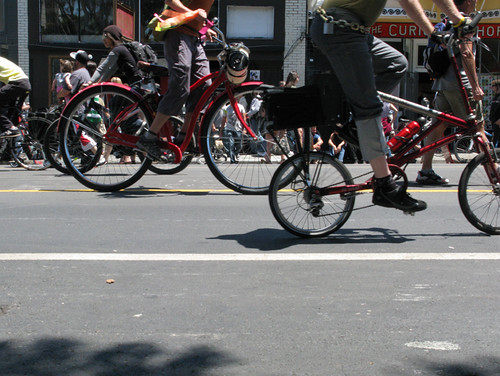
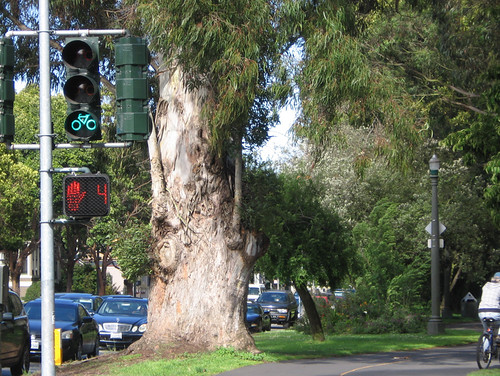


It’s really quite simple: By building more dedicated bike lanes and creating real bicycle equity, we not only eliminate the conflict between cyclists, pedestrians and drivers, but create an urban infrastructure that answers the 21st Century’s call for reduced carbon emissions and a smaller ecological footprint. The more bike lanes and car-free zones we can establish, the more public perception of what is “normal” will shift. As we can see in the examples of Copenhagen and Amsterdam, the bicycle can easily become the most commonly used commuter vehicle with the right infrastructure in place.
One major distinction between this kind of injustice and discrimination based on race, gender or sexual orientation is that we get the opportunity to walk in each others’ shoes. While we cannot directly experience what it’s like to be in someone else’s skin, we are indeed able to experience what it’s like to be on someone else’s road. In fact, it’s probably fair to say that most people who drive cars have ridden a bicycle before, and vice versa. It’s almost as if we’re getting training wheels in our practice of tolerance here, so let’s take this great invitation and change the way we commute!
o~O~o~O~o~O~o~O~o~O~o~O~o~O~o~O~o~O~o
photos by Sven Eberlein, except where credited
Resources:
http://www.bikeleague.org
http://bicyclesafe.com
SF Bicycle Coalition
National Bicycling and Walking Study
National Household Travel Survey, 2001








I just do not know what to say. I loved the way you explained your thoughts about the issue, and it’s interesting to see what made you to post this blog. 🙂 Hope this situation will change in our countries. In Ukraine it’s even worse.
I think one of the most brilliant things I’ve heard of is the Dutch traffic school, which they have all through primary education – they play the roles of pedestrian, cyclist and driver, working their way up in responsibility from one to the next, and if they break the law at one point, they are demoted. This both gives them an understanding of how to relate to other modes of transport, as well as a sense that differing modes of transportation hold different levels of responsibility for maintaining safety on the roads.
Of course their efforts to make walking and cycling *more* convenient than driving don’t hurt anything 🙂
Plus they also create a legal structure in which the most vulnerable road users are actually protected, rather than favoring cars in all but the most blatant cases, and sometimes even then. It’s been said, if you want to kill someone in Oregon, use a car.
Dave, it’s true, the Dutch are way ahead in the bicycle department. One of my favorite activities ever was to sit in an Amsterdam street cafe and watch the interaction between cyclists, drivers and pedestrians. It’s hard to understand how much built-in power and overconfidence drivers have in the States and other countries until you see completely different behavior in the streets of Holland. I hadn’t heard about the traffic school, but it makes perfect sense, because drivers there seem to be much more aware and respectful of their cyclist brethren. Here are some fun photos I took on that trip:
http://www.flickr.com/photos/11217210@N08/sets/72157621115273626/
Nice article, very well done.